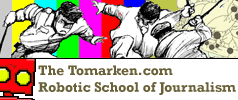A few thoughts on Googlewhacking. For those not in the know, the premise of this new search engine nerd-game is simple. Using Google, find pairs of words that return only one result. The player is not allowed to use quotation marks in her query, as Google returns then a phrase, the two words immediately adjacent to each other, and that’s just too easy. Here are some helpful hints from unblinking.com.
- Googlefactors must exist in this dictionary. It’s so easy to confirm: Google does the work! In the blue bar atop your Google results, accepted terms are linked to dictionary.com, and so appear ‘underlined.’ No line, no link = Googlejack!
- Google also is the arbiter of a whack’s uniqueness. Look to the right end of the blue bar atop your Google results. If you see “Results 1 - 1 of (any number),’ you found exactly one hit = Googlewhack!
- Google shows you an excerpt of the page you whacked. Look at that text. If it’s merely a list of words, No Whack For You!
Once the Googlewhack is found, post it on the internet (aka. here at tomarken.com) and then it is gone forever. So what are we supposed to make of all this? My big question, of course, was “Is there any critical precedent for presenting cultural phenomena (with no obvious ‘artist’) as faux-readymade art objects?” How about Dave Hickey? Re-reading his phenomenal book, Air Guitar, again, just to make sure I had the facts straight, I realized that while he was doing this, he wasn’t really meaning to. And even if he was, Googlewhacking goes way beyond customizing cars.
An old note in my copy of Air Guitar reads:
“I am interested in a sedated beauty, a beauty of refined clarity of thought…elegance.
I am not interested in gaudy things, over the top things, aka. German Expressionism. Visually, we don’t need German Expressionism, if we have Norman Rockwell or Aeon Flux.”
And as much as I feel everything that Dave says about Liberace, Las Vegas, and tailfins, I can’t help but think that it’s all losing out by the second. A new innovation in design is imminent Dave, and it’s an aesthetic of function. The question at hand, of course, is what we want to see, and what we want to see represented. I contend that what we want to see is changing from the frantic visual experience of a Beckmann (Max), a Barnett Newmann, a Rothko, (godforbid) a Pollock, to the elegant, refined aesthetic of Google.com.
Where we square up, however, is democracy. And folks, Google is democracy. And Googlewhacking is Dave’s hotrodding for the online generation.
Take democracy out of a monetary economy, and put it in an information economy. Leave all the implications of that aside. Stir.
Try Googlewhacking as a folk-perception of metadata - a sort of poignant, however inane fascination forged from a structure so overwhelming that it defies any conventional conceptual understanding. I.e. The question “what does google mean?” is so fucking hard to wrap your brain around, that instead “let’s see if we can add some functionality to it.” That’s what it is. It’s a phenomenon that in comparison to the obnoxious (and I mean that) practicalities of Dave’s world of buying and selling and trading and bullshit, is almost instantaneously discredited as time wasting. But as Dave might say, it’s “promoting rebellion, proposing outrageous reconfigurations and different ideas of how the world should look,” (63) in an information economy.
Now I’m going to take this all maybe one step farther than I should. I contend as such that Googlewhacking parallels the readymade. First off, let’s face it - the people who subsume the traditional cultural role of the artist on the internet are a completely different community than those who assume it in the real world. Dave wouldn’t argue with this. Moreover, since the unaltered found object will be considered a viable art object when placed in an art context, why not the constantly altered net-cultural phenomenon? One of the more general premises of making art in the network is that it can be based on viewers interactively manipulating the piece, see asmp v1.0. Given that this is a relevant premise for a new new-media art, and its based on so many principles that Duchamp himself really started rolling, I feel that this phenomonon is out there for the taking.
As such, on this eleventh day of March, in the year of our lord two-thousand and two, I claim as an art object, and moreover as a critical acheivement, Googlewhacking. The piece is entitled Net-Critical Achievement 1: Googlewhacking & Democracy, and it is © All Rights Reserved, Richard Tebrick, 3.11.2002.
For clarification, I am in no way claiming that I had anything to do with the inception of this phenomenon, moreover, I am not claiming that I had anything to do with the development of this phenomenon. (Other than playing the game, and here is my Googlewhack, my signature on NCA1: “vexillology apologia”.
Richard Tebrick, 3.11.2002.










